MGT603: Systems Thinking Report on ADM Company's Supply Chain Issues
VerifiedAdded on 2023/01/19
|9
|1827
|34
Report
AI Summary
This report presents a comprehensive CATWOE analysis of the Archer Daniels Midland Company (ADM), focusing on its supply chain issues and the need to improve relationships with farmers. The analysis identifies the key stakeholders, including clients (food industries and farmers), actors (employees), the transformation process (marketing), worldview (farmers' pricing expectations), owners (ADM management), and environmental constraints (internal regulations). The report highlights the importance of farmers as primary stakeholders and emphasizes the need for ADM to address the supply shortage by improving relationships and offering competitive rates. The conclusion underscores the significance of the CATWOE framework in creating a root definition report to investigate the business system and suggests that ADM should prioritize enhancing relationships with farmers and farm owners to resolve its supply chain challenges. The report includes a rich picture diagram to visually represent the complex situation and provides references supporting the analysis.
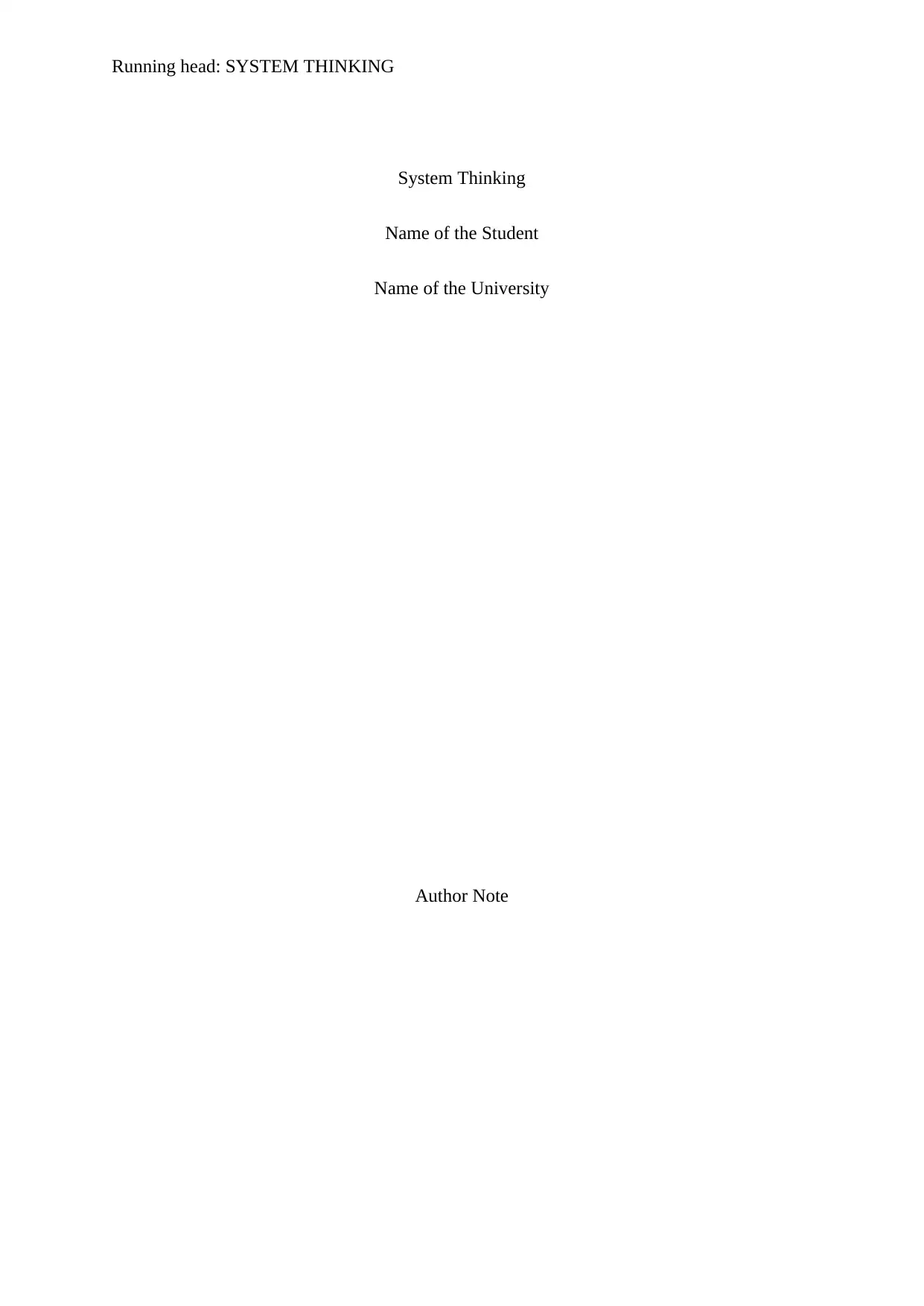
Running head: SYSTEM THINKING
System Thinking
Name of the Student
Name of the University
Author Note
System Thinking
Name of the Student
Name of the University
Author Note
Paraphrase This Document
Need a fresh take? Get an instant paraphrase of this document with our AI Paraphraser
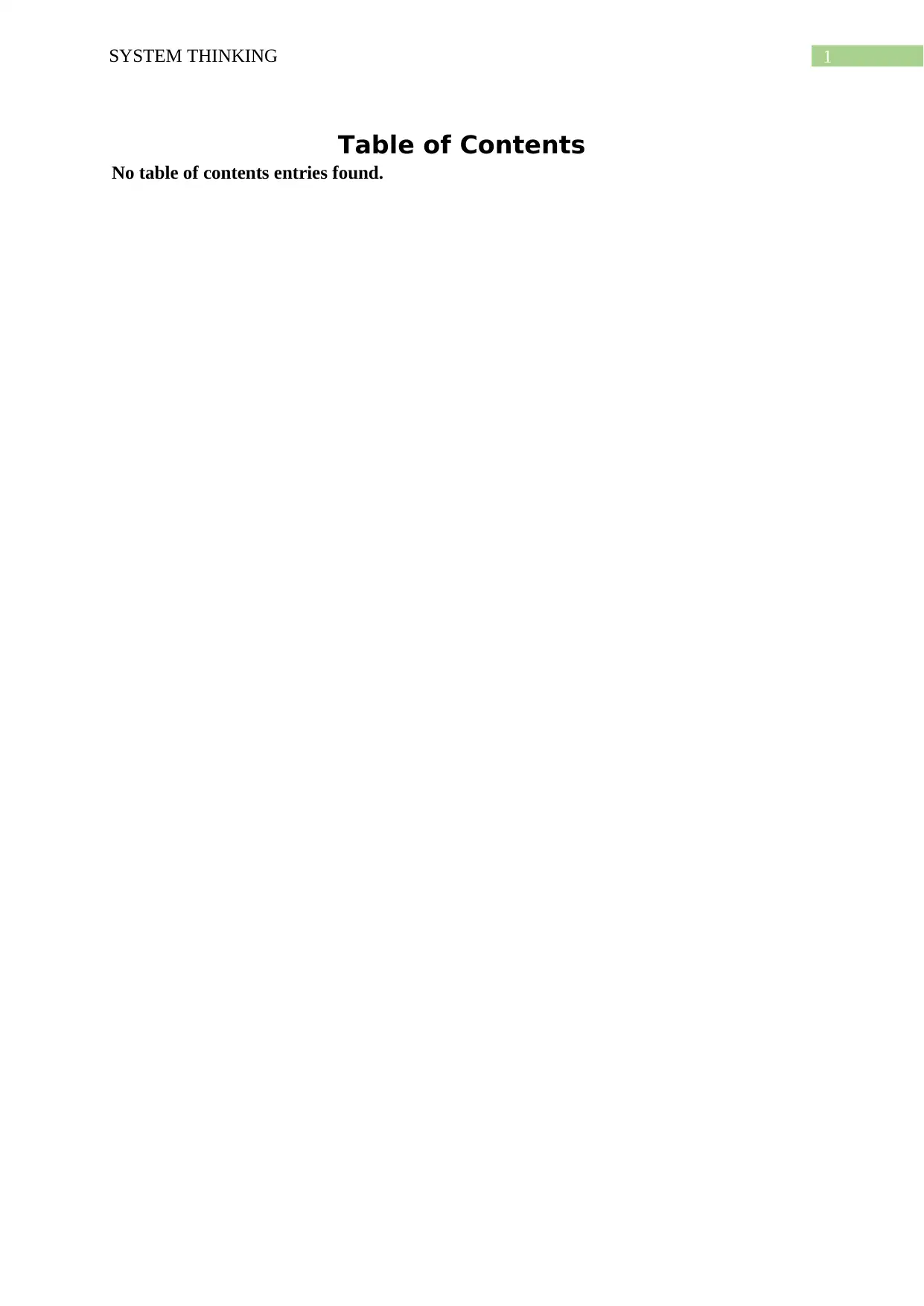
1SYSTEM THINKING
Table of Contents
No table of contents entries found.
Table of Contents
No table of contents entries found.
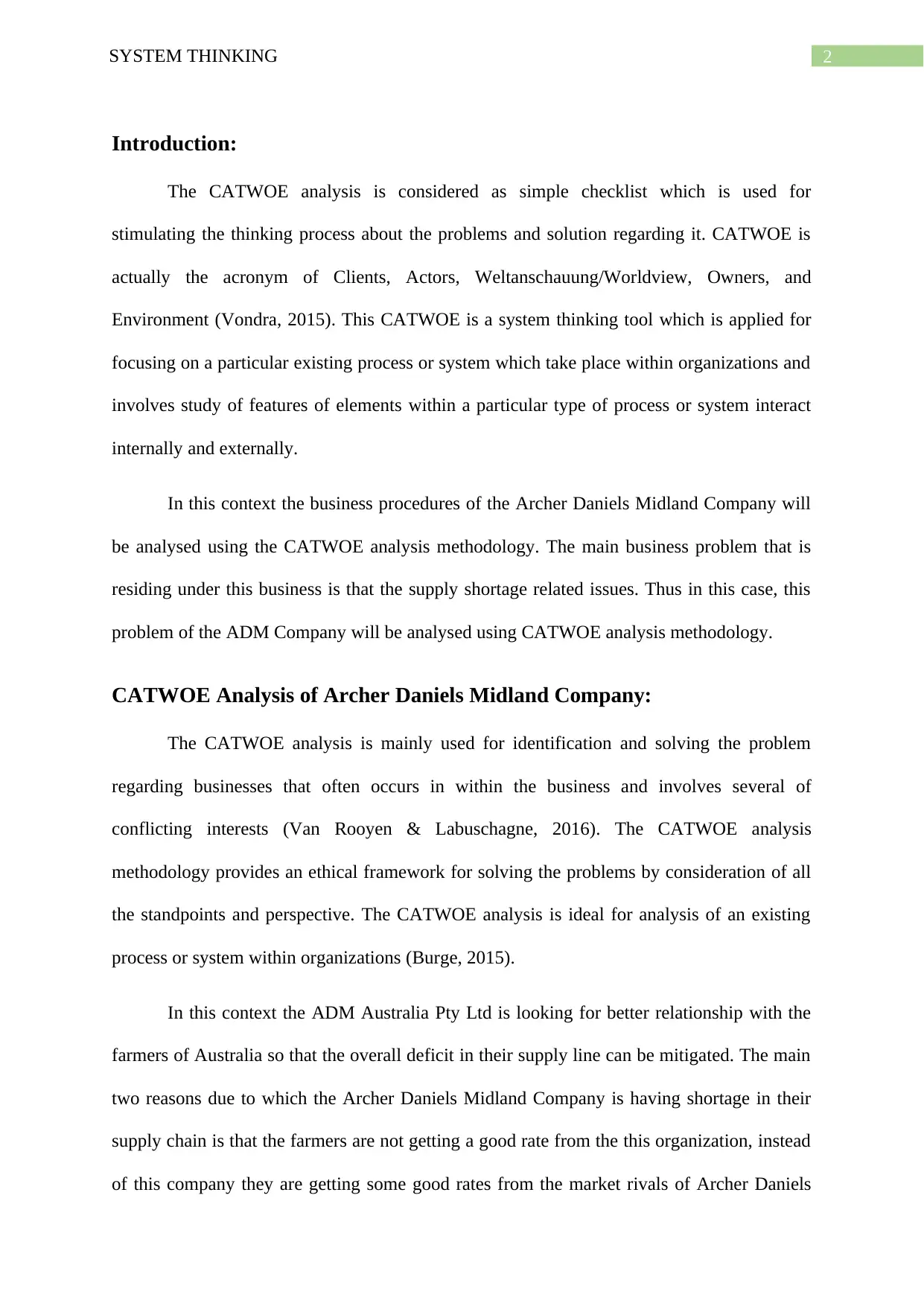
2SYSTEM THINKING
Introduction:
The CATWOE analysis is considered as simple checklist which is used for
stimulating the thinking process about the problems and solution regarding it. CATWOE is
actually the acronym of Clients, Actors, Weltanschauung/Worldview, Owners, and
Environment (Vondra, 2015). This CATWOE is a system thinking tool which is applied for
focusing on a particular existing process or system which take place within organizations and
involves study of features of elements within a particular type of process or system interact
internally and externally.
In this context the business procedures of the Archer Daniels Midland Company will
be analysed using the CATWOE analysis methodology. The main business problem that is
residing under this business is that the supply shortage related issues. Thus in this case, this
problem of the ADM Company will be analysed using CATWOE analysis methodology.
CATWOE Analysis of Archer Daniels Midland Company:
The CATWOE analysis is mainly used for identification and solving the problem
regarding businesses that often occurs in within the business and involves several of
conflicting interests (Van Rooyen & Labuschagne, 2016). The CATWOE analysis
methodology provides an ethical framework for solving the problems by consideration of all
the standpoints and perspective. The CATWOE analysis is ideal for analysis of an existing
process or system within organizations (Burge, 2015).
In this context the ADM Australia Pty Ltd is looking for better relationship with the
farmers of Australia so that the overall deficit in their supply line can be mitigated. The main
two reasons due to which the Archer Daniels Midland Company is having shortage in their
supply chain is that the farmers are not getting a good rate from the this organization, instead
of this company they are getting some good rates from the market rivals of Archer Daniels
Introduction:
The CATWOE analysis is considered as simple checklist which is used for
stimulating the thinking process about the problems and solution regarding it. CATWOE is
actually the acronym of Clients, Actors, Weltanschauung/Worldview, Owners, and
Environment (Vondra, 2015). This CATWOE is a system thinking tool which is applied for
focusing on a particular existing process or system which take place within organizations and
involves study of features of elements within a particular type of process or system interact
internally and externally.
In this context the business procedures of the Archer Daniels Midland Company will
be analysed using the CATWOE analysis methodology. The main business problem that is
residing under this business is that the supply shortage related issues. Thus in this case, this
problem of the ADM Company will be analysed using CATWOE analysis methodology.
CATWOE Analysis of Archer Daniels Midland Company:
The CATWOE analysis is mainly used for identification and solving the problem
regarding businesses that often occurs in within the business and involves several of
conflicting interests (Van Rooyen & Labuschagne, 2016). The CATWOE analysis
methodology provides an ethical framework for solving the problems by consideration of all
the standpoints and perspective. The CATWOE analysis is ideal for analysis of an existing
process or system within organizations (Burge, 2015).
In this context the ADM Australia Pty Ltd is looking for better relationship with the
farmers of Australia so that the overall deficit in their supply line can be mitigated. The main
two reasons due to which the Archer Daniels Midland Company is having shortage in their
supply chain is that the farmers are not getting a good rate from the this organization, instead
of this company they are getting some good rates from the market rivals of Archer Daniels
⊘ This is a preview!⊘
Do you want full access?
Subscribe today to unlock all pages.

Trusted by 1+ million students worldwide
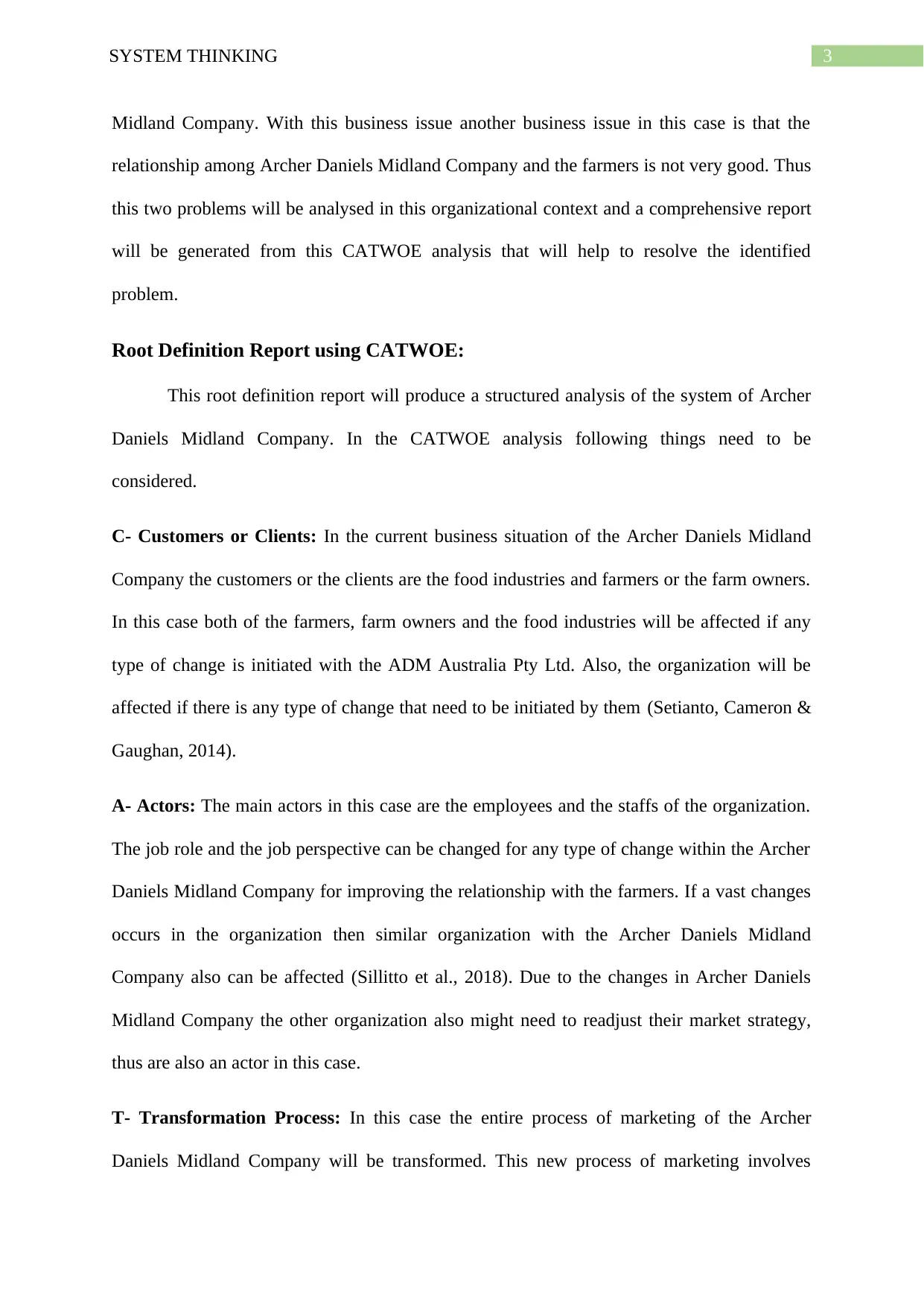
3SYSTEM THINKING
Midland Company. With this business issue another business issue in this case is that the
relationship among Archer Daniels Midland Company and the farmers is not very good. Thus
this two problems will be analysed in this organizational context and a comprehensive report
will be generated from this CATWOE analysis that will help to resolve the identified
problem.
Root Definition Report using CATWOE:
This root definition report will produce a structured analysis of the system of Archer
Daniels Midland Company. In the CATWOE analysis following things need to be
considered.
C- Customers or Clients: In the current business situation of the Archer Daniels Midland
Company the customers or the clients are the food industries and farmers or the farm owners.
In this case both of the farmers, farm owners and the food industries will be affected if any
type of change is initiated with the ADM Australia Pty Ltd. Also, the organization will be
affected if there is any type of change that need to be initiated by them (Setianto, Cameron &
Gaughan, 2014).
A- Actors: The main actors in this case are the employees and the staffs of the organization.
The job role and the job perspective can be changed for any type of change within the Archer
Daniels Midland Company for improving the relationship with the farmers. If a vast changes
occurs in the organization then similar organization with the Archer Daniels Midland
Company also can be affected (Sillitto et al., 2018). Due to the changes in Archer Daniels
Midland Company the other organization also might need to readjust their market strategy,
thus are also an actor in this case.
T- Transformation Process: In this case the entire process of marketing of the Archer
Daniels Midland Company will be transformed. This new process of marketing involves
Midland Company. With this business issue another business issue in this case is that the
relationship among Archer Daniels Midland Company and the farmers is not very good. Thus
this two problems will be analysed in this organizational context and a comprehensive report
will be generated from this CATWOE analysis that will help to resolve the identified
problem.
Root Definition Report using CATWOE:
This root definition report will produce a structured analysis of the system of Archer
Daniels Midland Company. In the CATWOE analysis following things need to be
considered.
C- Customers or Clients: In the current business situation of the Archer Daniels Midland
Company the customers or the clients are the food industries and farmers or the farm owners.
In this case both of the farmers, farm owners and the food industries will be affected if any
type of change is initiated with the ADM Australia Pty Ltd. Also, the organization will be
affected if there is any type of change that need to be initiated by them (Setianto, Cameron &
Gaughan, 2014).
A- Actors: The main actors in this case are the employees and the staffs of the organization.
The job role and the job perspective can be changed for any type of change within the Archer
Daniels Midland Company for improving the relationship with the farmers. If a vast changes
occurs in the organization then similar organization with the Archer Daniels Midland
Company also can be affected (Sillitto et al., 2018). Due to the changes in Archer Daniels
Midland Company the other organization also might need to readjust their market strategy,
thus are also an actor in this case.
T- Transformation Process: In this case the entire process of marketing of the Archer
Daniels Midland Company will be transformed. This new process of marketing involves
Paraphrase This Document
Need a fresh take? Get an instant paraphrase of this document with our AI Paraphraser
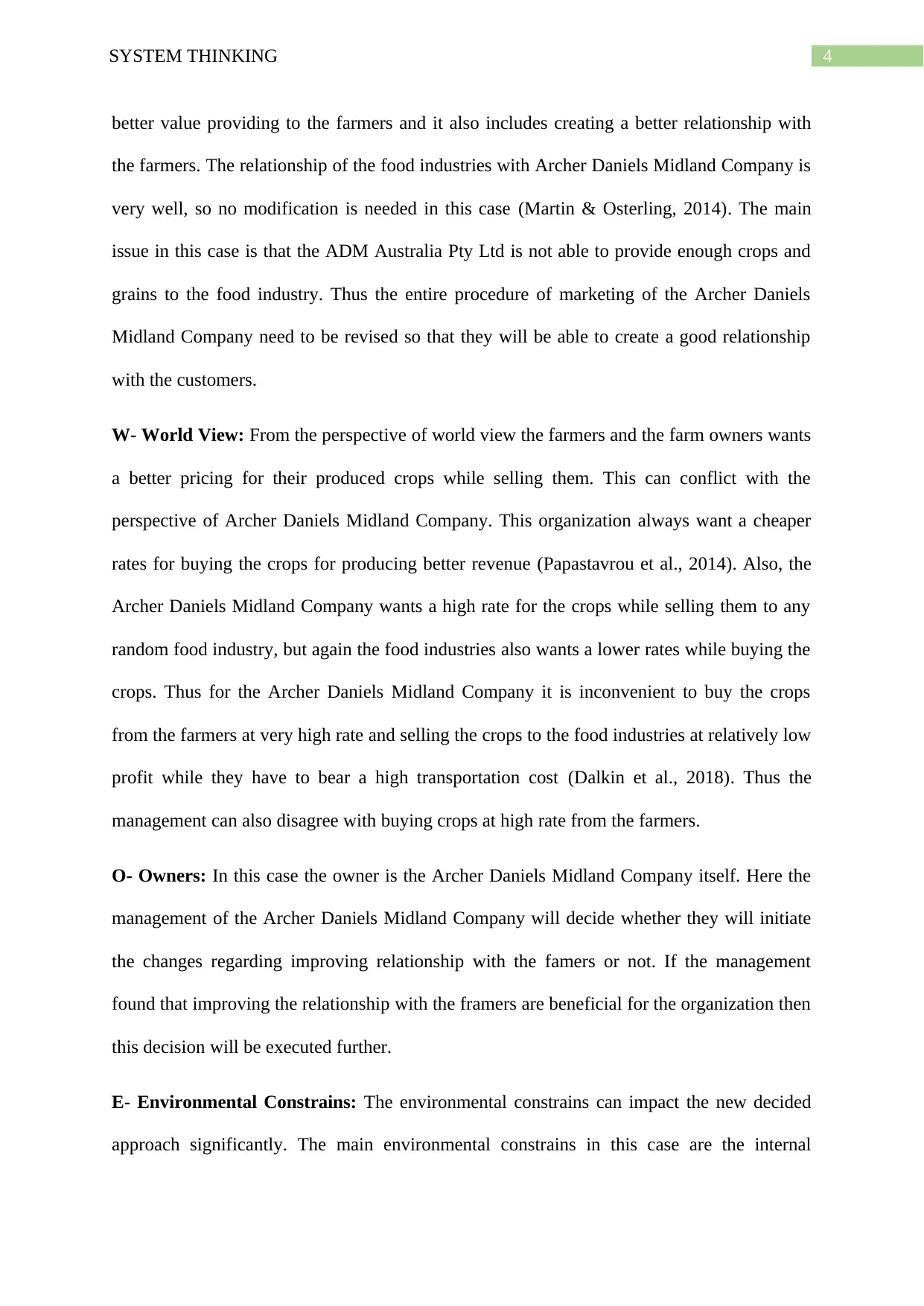
4SYSTEM THINKING
better value providing to the farmers and it also includes creating a better relationship with
the farmers. The relationship of the food industries with Archer Daniels Midland Company is
very well, so no modification is needed in this case (Martin & Osterling, 2014). The main
issue in this case is that the ADM Australia Pty Ltd is not able to provide enough crops and
grains to the food industry. Thus the entire procedure of marketing of the Archer Daniels
Midland Company need to be revised so that they will be able to create a good relationship
with the customers.
W- World View: From the perspective of world view the farmers and the farm owners wants
a better pricing for their produced crops while selling them. This can conflict with the
perspective of Archer Daniels Midland Company. This organization always want a cheaper
rates for buying the crops for producing better revenue (Papastavrou et al., 2014). Also, the
Archer Daniels Midland Company wants a high rate for the crops while selling them to any
random food industry, but again the food industries also wants a lower rates while buying the
crops. Thus for the Archer Daniels Midland Company it is inconvenient to buy the crops
from the farmers at very high rate and selling the crops to the food industries at relatively low
profit while they have to bear a high transportation cost (Dalkin et al., 2018). Thus the
management can also disagree with buying crops at high rate from the farmers.
O- Owners: In this case the owner is the Archer Daniels Midland Company itself. Here the
management of the Archer Daniels Midland Company will decide whether they will initiate
the changes regarding improving relationship with the famers or not. If the management
found that improving the relationship with the framers are beneficial for the organization then
this decision will be executed further.
E- Environmental Constrains: The environmental constrains can impact the new decided
approach significantly. The main environmental constrains in this case are the internal
better value providing to the farmers and it also includes creating a better relationship with
the farmers. The relationship of the food industries with Archer Daniels Midland Company is
very well, so no modification is needed in this case (Martin & Osterling, 2014). The main
issue in this case is that the ADM Australia Pty Ltd is not able to provide enough crops and
grains to the food industry. Thus the entire procedure of marketing of the Archer Daniels
Midland Company need to be revised so that they will be able to create a good relationship
with the customers.
W- World View: From the perspective of world view the farmers and the farm owners wants
a better pricing for their produced crops while selling them. This can conflict with the
perspective of Archer Daniels Midland Company. This organization always want a cheaper
rates for buying the crops for producing better revenue (Papastavrou et al., 2014). Also, the
Archer Daniels Midland Company wants a high rate for the crops while selling them to any
random food industry, but again the food industries also wants a lower rates while buying the
crops. Thus for the Archer Daniels Midland Company it is inconvenient to buy the crops
from the farmers at very high rate and selling the crops to the food industries at relatively low
profit while they have to bear a high transportation cost (Dalkin et al., 2018). Thus the
management can also disagree with buying crops at high rate from the farmers.
O- Owners: In this case the owner is the Archer Daniels Midland Company itself. Here the
management of the Archer Daniels Midland Company will decide whether they will initiate
the changes regarding improving relationship with the famers or not. If the management
found that improving the relationship with the framers are beneficial for the organization then
this decision will be executed further.
E- Environmental Constrains: The environmental constrains can impact the new decided
approach significantly. The main environmental constrains in this case are the internal
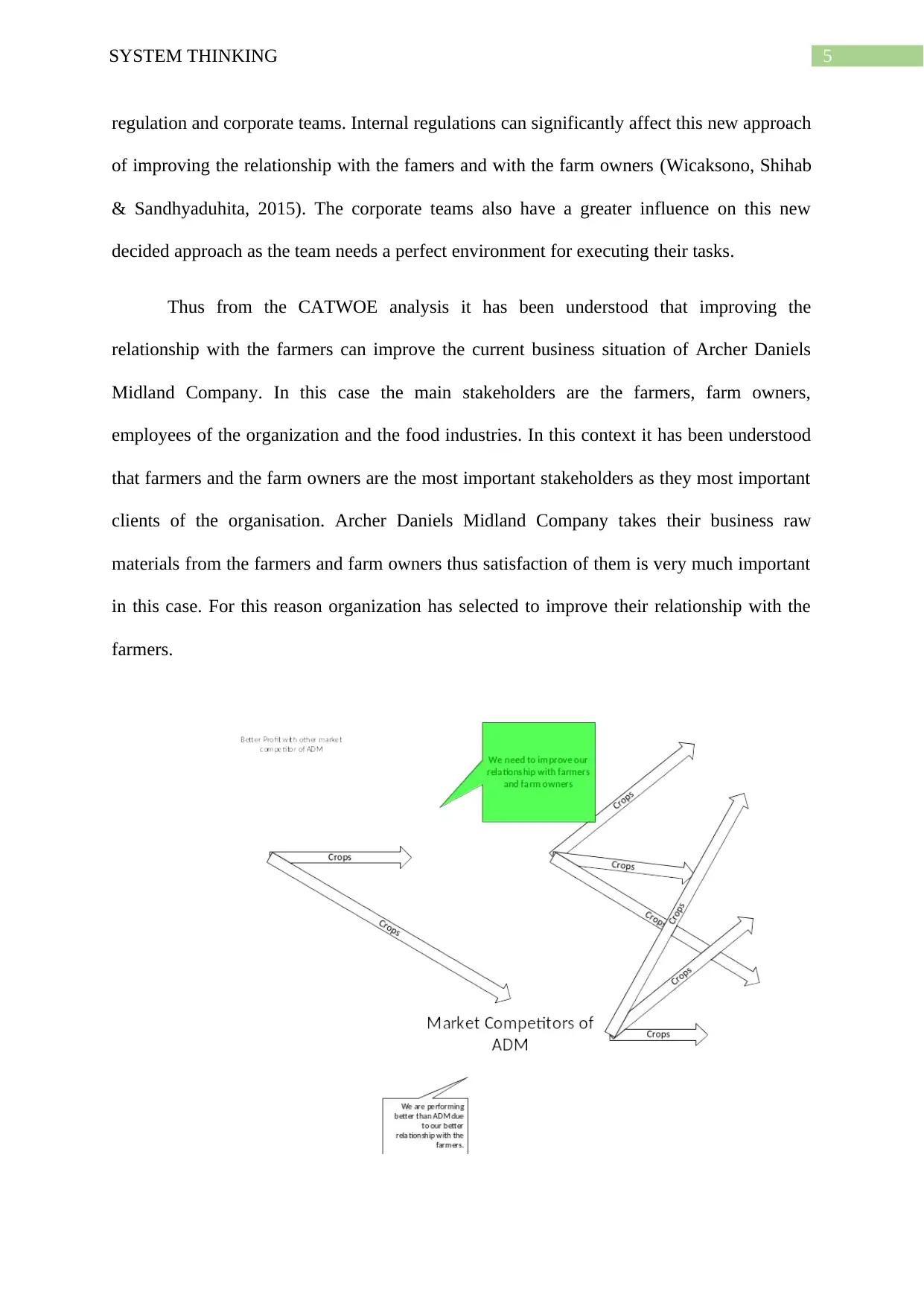
5SYSTEM THINKING
regulation and corporate teams. Internal regulations can significantly affect this new approach
of improving the relationship with the famers and with the farm owners (Wicaksono, Shihab
& Sandhyaduhita, 2015). The corporate teams also have a greater influence on this new
decided approach as the team needs a perfect environment for executing their tasks.
Thus from the CATWOE analysis it has been understood that improving the
relationship with the farmers can improve the current business situation of Archer Daniels
Midland Company. In this case the main stakeholders are the farmers, farm owners,
employees of the organization and the food industries. In this context it has been understood
that farmers and the farm owners are the most important stakeholders as they most important
clients of the organisation. Archer Daniels Midland Company takes their business raw
materials from the farmers and farm owners thus satisfaction of them is very much important
in this case. For this reason organization has selected to improve their relationship with the
farmers.
regulation and corporate teams. Internal regulations can significantly affect this new approach
of improving the relationship with the famers and with the farm owners (Wicaksono, Shihab
& Sandhyaduhita, 2015). The corporate teams also have a greater influence on this new
decided approach as the team needs a perfect environment for executing their tasks.
Thus from the CATWOE analysis it has been understood that improving the
relationship with the farmers can improve the current business situation of Archer Daniels
Midland Company. In this case the main stakeholders are the farmers, farm owners,
employees of the organization and the food industries. In this context it has been understood
that farmers and the farm owners are the most important stakeholders as they most important
clients of the organisation. Archer Daniels Midland Company takes their business raw
materials from the farmers and farm owners thus satisfaction of them is very much important
in this case. For this reason organization has selected to improve their relationship with the
farmers.
⊘ This is a preview!⊘
Do you want full access?
Subscribe today to unlock all pages.

Trusted by 1+ million students worldwide
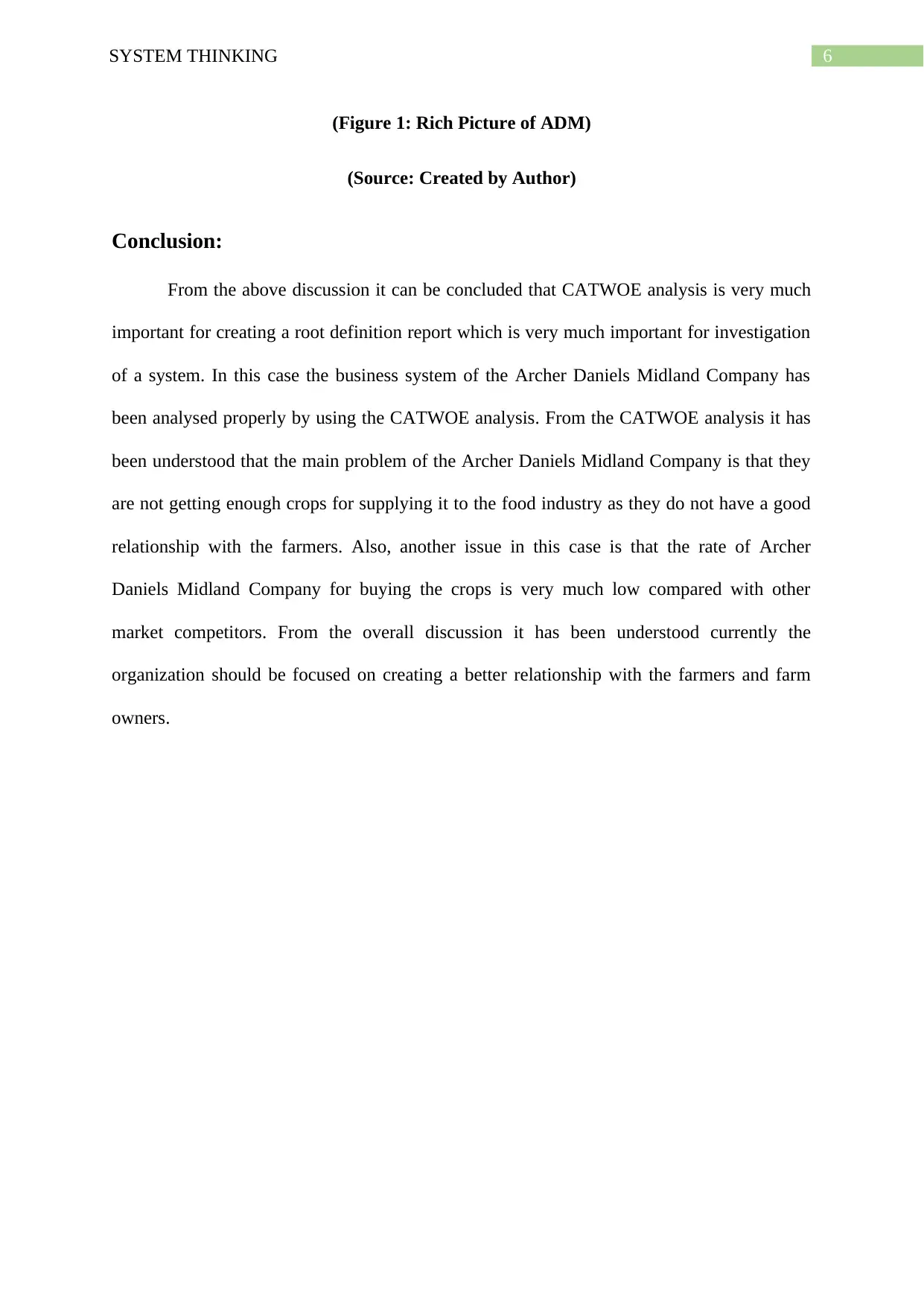
6SYSTEM THINKING
(Figure 1: Rich Picture of ADM)
(Source: Created by Author)
Conclusion:
From the above discussion it can be concluded that CATWOE analysis is very much
important for creating a root definition report which is very much important for investigation
of a system. In this case the business system of the Archer Daniels Midland Company has
been analysed properly by using the CATWOE analysis. From the CATWOE analysis it has
been understood that the main problem of the Archer Daniels Midland Company is that they
are not getting enough crops for supplying it to the food industry as they do not have a good
relationship with the farmers. Also, another issue in this case is that the rate of Archer
Daniels Midland Company for buying the crops is very much low compared with other
market competitors. From the overall discussion it has been understood currently the
organization should be focused on creating a better relationship with the farmers and farm
owners.
(Figure 1: Rich Picture of ADM)
(Source: Created by Author)
Conclusion:
From the above discussion it can be concluded that CATWOE analysis is very much
important for creating a root definition report which is very much important for investigation
of a system. In this case the business system of the Archer Daniels Midland Company has
been analysed properly by using the CATWOE analysis. From the CATWOE analysis it has
been understood that the main problem of the Archer Daniels Midland Company is that they
are not getting enough crops for supplying it to the food industry as they do not have a good
relationship with the farmers. Also, another issue in this case is that the rate of Archer
Daniels Midland Company for buying the crops is very much low compared with other
market competitors. From the overall discussion it has been understood currently the
organization should be focused on creating a better relationship with the farmers and farm
owners.
Paraphrase This Document
Need a fresh take? Get an instant paraphrase of this document with our AI Paraphraser
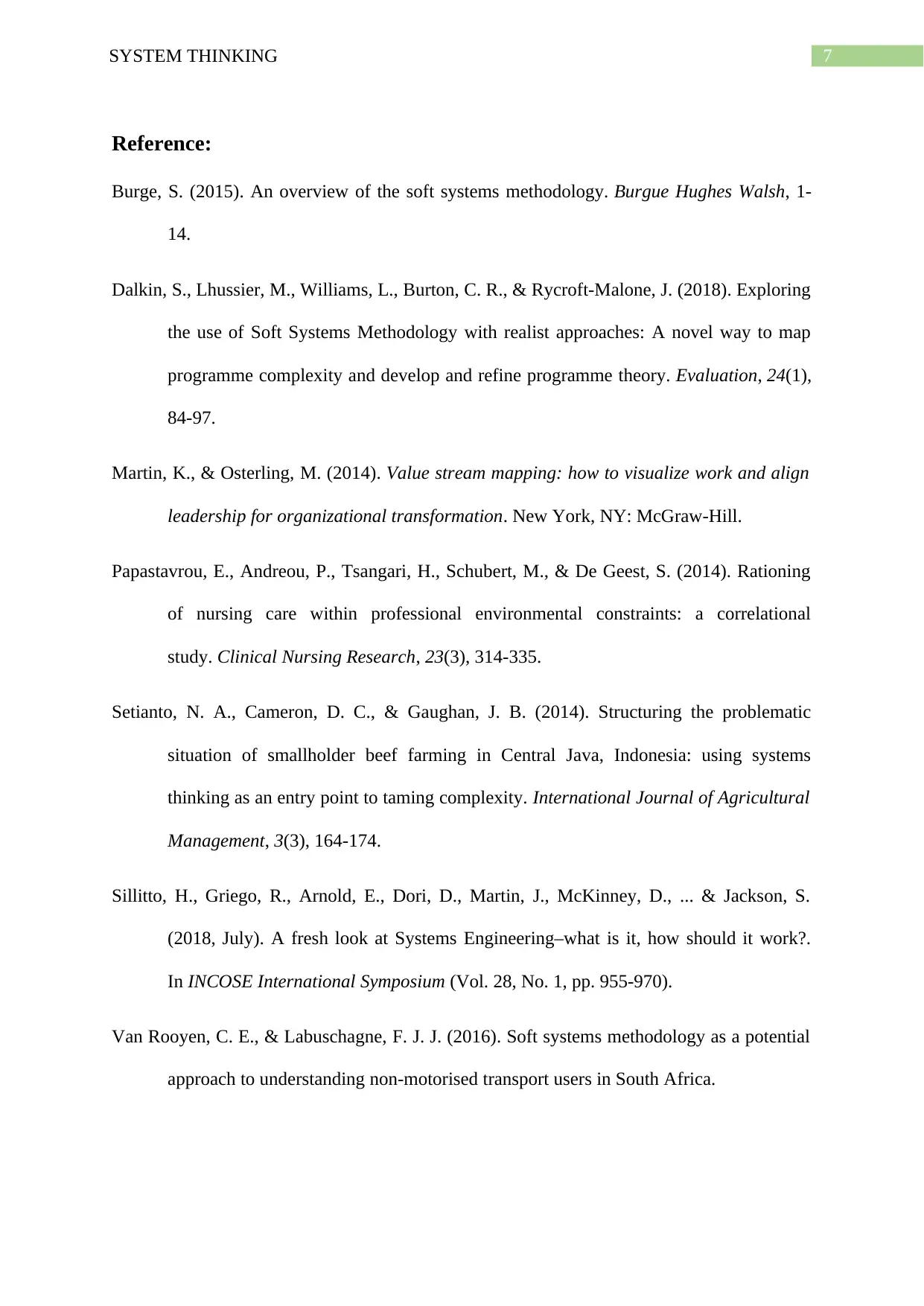
7SYSTEM THINKING
Reference:
Burge, S. (2015). An overview of the soft systems methodology. Burgue Hughes Walsh, 1-
14.
Dalkin, S., Lhussier, M., Williams, L., Burton, C. R., & Rycroft-Malone, J. (2018). Exploring
the use of Soft Systems Methodology with realist approaches: A novel way to map
programme complexity and develop and refine programme theory. Evaluation, 24(1),
84-97.
Martin, K., & Osterling, M. (2014). Value stream mapping: how to visualize work and align
leadership for organizational transformation. New York, NY: McGraw-Hill.
Papastavrou, E., Andreou, P., Tsangari, H., Schubert, M., & De Geest, S. (2014). Rationing
of nursing care within professional environmental constraints: a correlational
study. Clinical Nursing Research, 23(3), 314-335.
Setianto, N. A., Cameron, D. C., & Gaughan, J. B. (2014). Structuring the problematic
situation of smallholder beef farming in Central Java, Indonesia: using systems
thinking as an entry point to taming complexity. International Journal of Agricultural
Management, 3(3), 164-174.
Sillitto, H., Griego, R., Arnold, E., Dori, D., Martin, J., McKinney, D., ... & Jackson, S.
(2018, July). A fresh look at Systems Engineering–what is it, how should it work?.
In INCOSE International Symposium (Vol. 28, No. 1, pp. 955-970).
Van Rooyen, C. E., & Labuschagne, F. J. J. (2016). Soft systems methodology as a potential
approach to understanding non-motorised transport users in South Africa.
Reference:
Burge, S. (2015). An overview of the soft systems methodology. Burgue Hughes Walsh, 1-
14.
Dalkin, S., Lhussier, M., Williams, L., Burton, C. R., & Rycroft-Malone, J. (2018). Exploring
the use of Soft Systems Methodology with realist approaches: A novel way to map
programme complexity and develop and refine programme theory. Evaluation, 24(1),
84-97.
Martin, K., & Osterling, M. (2014). Value stream mapping: how to visualize work and align
leadership for organizational transformation. New York, NY: McGraw-Hill.
Papastavrou, E., Andreou, P., Tsangari, H., Schubert, M., & De Geest, S. (2014). Rationing
of nursing care within professional environmental constraints: a correlational
study. Clinical Nursing Research, 23(3), 314-335.
Setianto, N. A., Cameron, D. C., & Gaughan, J. B. (2014). Structuring the problematic
situation of smallholder beef farming in Central Java, Indonesia: using systems
thinking as an entry point to taming complexity. International Journal of Agricultural
Management, 3(3), 164-174.
Sillitto, H., Griego, R., Arnold, E., Dori, D., Martin, J., McKinney, D., ... & Jackson, S.
(2018, July). A fresh look at Systems Engineering–what is it, how should it work?.
In INCOSE International Symposium (Vol. 28, No. 1, pp. 955-970).
Van Rooyen, C. E., & Labuschagne, F. J. J. (2016). Soft systems methodology as a potential
approach to understanding non-motorised transport users in South Africa.
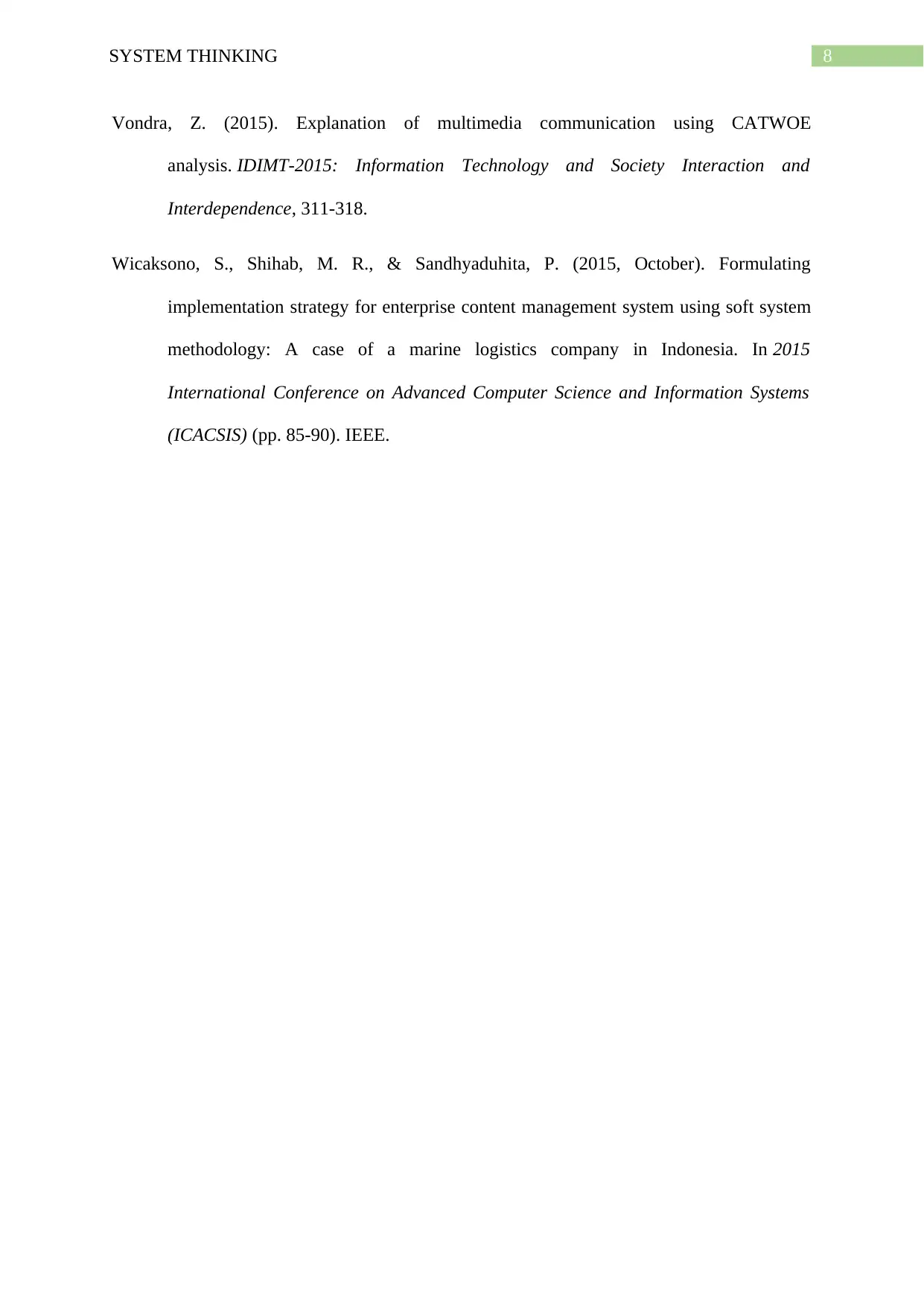
8SYSTEM THINKING
Vondra, Z. (2015). Explanation of multimedia communication using CATWOE
analysis. IDIMT-2015: Information Technology and Society Interaction and
Interdependence, 311-318.
Wicaksono, S., Shihab, M. R., & Sandhyaduhita, P. (2015, October). Formulating
implementation strategy for enterprise content management system using soft system
methodology: A case of a marine logistics company in Indonesia. In 2015
International Conference on Advanced Computer Science and Information Systems
(ICACSIS) (pp. 85-90). IEEE.
Vondra, Z. (2015). Explanation of multimedia communication using CATWOE
analysis. IDIMT-2015: Information Technology and Society Interaction and
Interdependence, 311-318.
Wicaksono, S., Shihab, M. R., & Sandhyaduhita, P. (2015, October). Formulating
implementation strategy for enterprise content management system using soft system
methodology: A case of a marine logistics company in Indonesia. In 2015
International Conference on Advanced Computer Science and Information Systems
(ICACSIS) (pp. 85-90). IEEE.
⊘ This is a preview!⊘
Do you want full access?
Subscribe today to unlock all pages.

Trusted by 1+ million students worldwide
1 out of 9
Related Documents
Your All-in-One AI-Powered Toolkit for Academic Success.
+13062052269
info@desklib.com
Available 24*7 on WhatsApp / Email
![[object Object]](/_next/static/media/star-bottom.7253800d.svg)
Unlock your academic potential
Copyright © 2020–2025 A2Z Services. All Rights Reserved. Developed and managed by ZUCOL.





